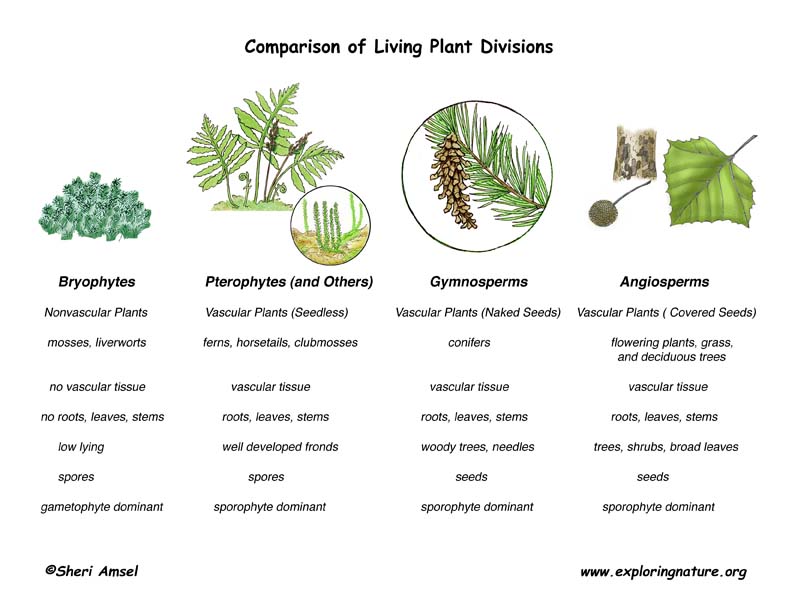
/home/sheriexplores/apps/router.php line 53 SQLSTATE[HY000]: General error: 144 Table './sheriexplores_exploredb/access_log' is marked as crashed and last (automatic?) repair failed

Most plants live on land, but some have adapted to wetland life. Plants are broken down into two main groups. They are either vascular or nonvascular.
VASCULAR PLANTS make up about 80% of all plants. They have special tissues in their stems to move water and nutrients up and down the plant (xylem and phloem). This allows the plant to grow to a much larger size. They are also characterized by their reproductive phase (sporophyte generation is dominant).
Vascular plants are broken down into three groups:
1) Seedless vascular plants (ferns, horsetails and clubmosses)
In this group the sporophyte(diploid) dominates and is separate from the gametophyte.
The gametophyte makes sperm that travel in water to reach the egg.
A new plant results.
2) Naked seed vascular plants (conifers, cycads, ginkos)
These are also called gymnosperms.
Gymnosperm seeds are not completely covered by the parent plant when they are formed. They are inside dangling cones.
Here are some of their traits:
a. In conifers (pine, spruce, fir, redwoods and cedars) the tree is the sporophyte generation (diploid).
b. The gametophyte generation is too small to see.
c. Males and female cones have haploid spores. Male cones release pollen in the spring, which is spread by the wind. Some reach female cones, which release a sticky fluid that traps the blowing pollen. The pollen, over time, will burrow into the female cone’s ovule to reach and fertilize the egg. Eventually, the cone will fall and in the right conditions grow into a conifer tree.
3) Protected seed vascular plants (flowering plants, grasses and deciduous trees) are also called angiosperms. Their seeds are protected inside a fruit. The flower grows to attract pollinators and house the ovule with eggs inside. It also holds the sperm that will be released as pollen.
NONVASCULAR PLANTS include the mosses, liverworts and hornworts.
These are also called bryophytes. They are small, short plants found in wet places.
Their gametophyte generation dominates.
The sporophyte generation grows from it and depends on it for food.
Assessment: Plants: Vascular vs. Nonvascular - Multiple Choice Test
When you research information you must cite the reference. Citing for websites is different from citing from books, magazines and periodicals. The style of citing shown here is from the MLA Style Citations (Modern Language Association).
When citing a WEBSITE the general format is as follows.
Author Last Name, First Name(s). "Title: Subtitle of Part of Web Page, if appropriate." Title: Subtitle: Section of Page if appropriate. Sponsoring/Publishing Agency, If Given. Additional significant descriptive information. Date of Electronic Publication or other Date, such as Last Updated. Day Month Year of access < URL >.
Amsel, Sheri. "Plant Kingdom Overview" Exploring Nature Educational Resource ©2005-2024. November 28, 2024
< http://www.exploringnature.org/db/view/41 >

